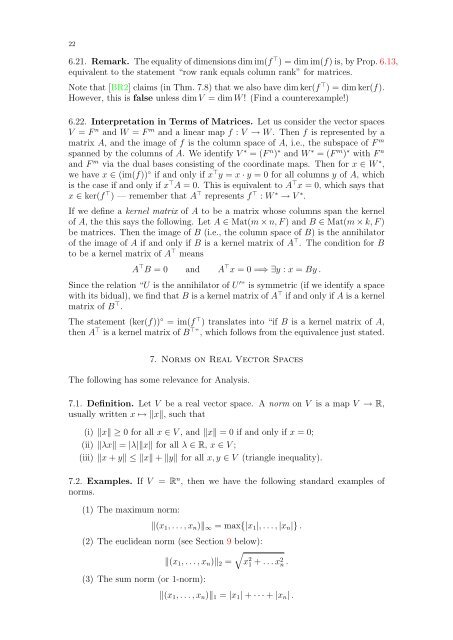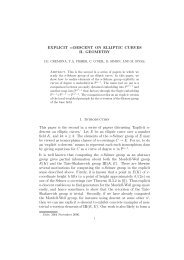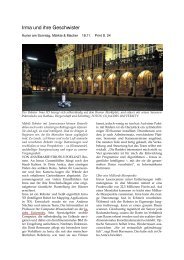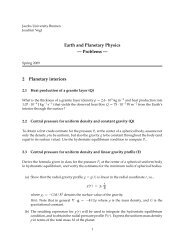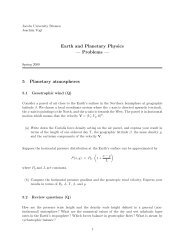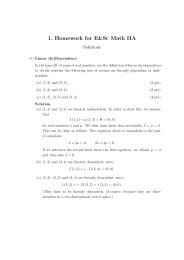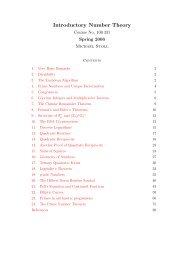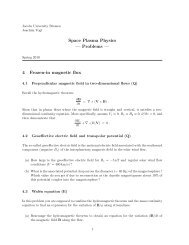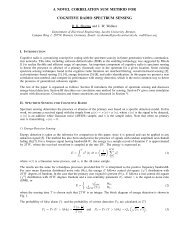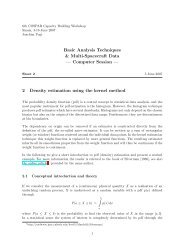Linear Algebra II (pdf, 500 kB)
Linear Algebra II (pdf, 500 kB)
Linear Algebra II (pdf, 500 kB)
Create successful ePaper yourself
Turn your PDF publications into a flip-book with our unique Google optimized e-Paper software.
22<br />
6.21. Remark. The equality of dimensions dim im(f ⊤ ) = dim im(f) is, by Prop. 6.13,<br />
equivalent to the statement “row rank equals column rank” for matrices.<br />
Note that [BR2] claims (in Thm. 7.8) that we also have dim ker(f ⊤ ) = dim ker(f).<br />
However, this is false unless dim V = dim W ! (Find a counterexample!)<br />
6.22. Interpretation in Terms of Matrices. Let us consider the vector spaces<br />
V = F n and W = F m and a linear map f : V → W . Then f is represented by a<br />
matrix A, and the image of f is the column space of A, i.e., the subspace of F m<br />
spanned by the columns of A. We identify V ∗ = (F n ) ∗ and W ∗ = (F m ) ∗ with F n<br />
and F m via the dual bases consisting of the coordinate maps. Then for x ∈ W ∗ ,<br />
we have x ∈ (im(f)) ◦ if and only if x ⊤ y = x · y = 0 for all columns y of A, which<br />
is the case if and only if x ⊤ A = 0. This is equivalent to A ⊤ x = 0, which says that<br />
x ∈ ker(f ⊤ ) — remember that A ⊤ represents f ⊤ : W ∗ → V ∗ .<br />
If we define a kernel matrix of A to be a matrix whose columns span the kernel<br />
of A, the this says the following. Let A ∈ Mat(m × n, F ) and B ∈ Mat(m × k, F )<br />
be matrices. Then the image of B (i.e., the column space of B) is the annihilator<br />
of the image of A if and only if B is a kernel matrix of A ⊤ . The condition for B<br />
to be a kernel matrix of A ⊤ means<br />
A ⊤ B = 0 and A ⊤ x = 0 =⇒ ∃y : x = By .<br />
Since the relation “U is the annihilator of U ′ ” is symmetric (if we identify a space<br />
with its bidual), we find that B is a kernel matrix of A ⊤ if and only if A is a kernel<br />
matrix of B ⊤ .<br />
The statement (ker(f)) ◦ = im(f ⊤ ) translates into “if B is a kernel matrix of A,<br />
then A ⊤ is a kernel matrix of B ⊤ ”, which follows from the equivalence just stated.<br />
7. Norms on Real Vector Spaces<br />
The following has some relevance for Analysis.<br />
7.1. Definition. Let V be a real vector space. A norm on V is a map V → R,<br />
usually written x ↦→ x, such that<br />
(i) x ≥ 0 for all x ∈ V , and x = 0 if and only if x = 0;<br />
(ii) λx = |λ|x for all λ ∈ R, x ∈ V ;<br />
(iii) x + y ≤ x + y for all x, y ∈ V (triangle inequality).<br />
7.2. Examples. If V = R n , then we have the following standard examples of<br />
norms.<br />
(1) The maximum norm:<br />
(x1, . . . , xn)∞ = max{|x1|, . . . , |xn|} .<br />
(2) The euclidean norm (see Section 9 below):<br />
<br />
(x1, . . . , xn)2 = x2 1 + . . . x2 n .<br />
(3) The sum norm (or 1-norm):<br />
(x1, . . . , xn)1 = |x1| + · · · + |xn| .


